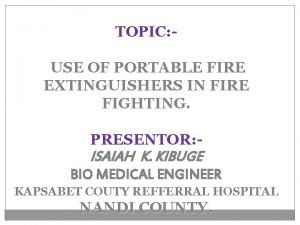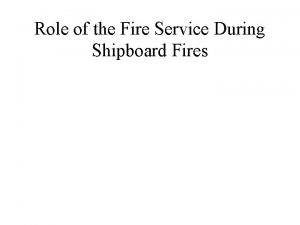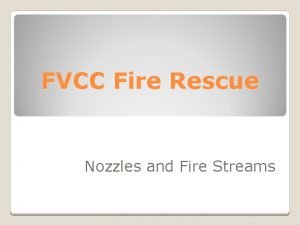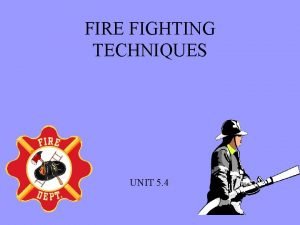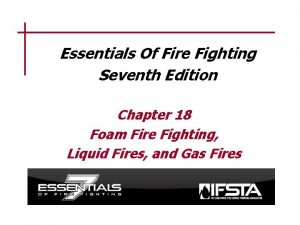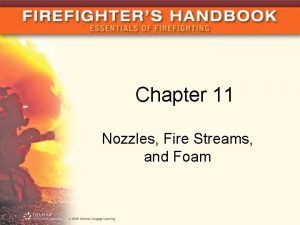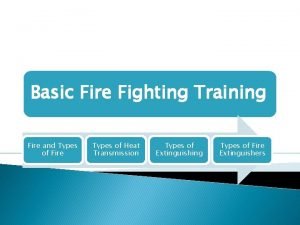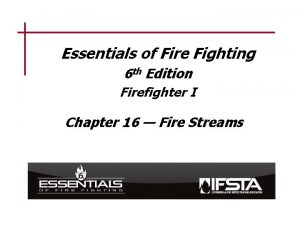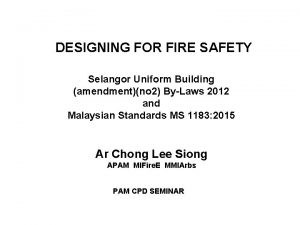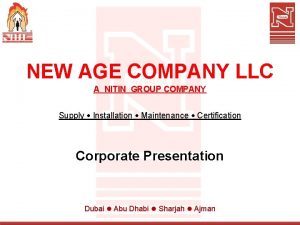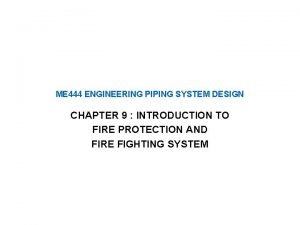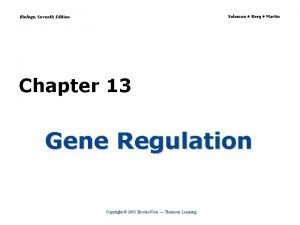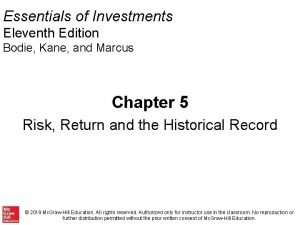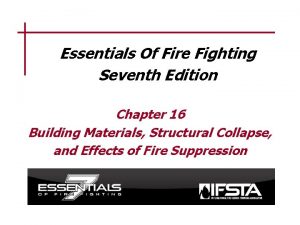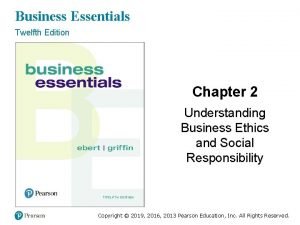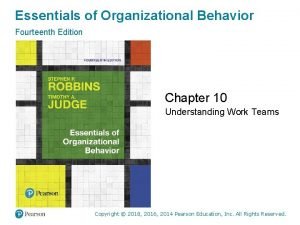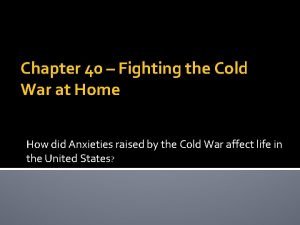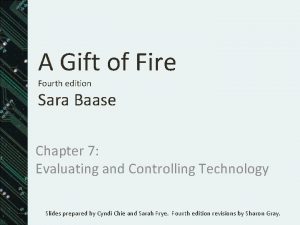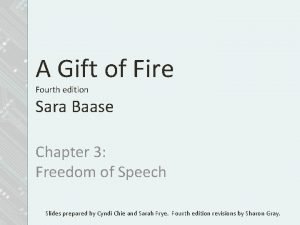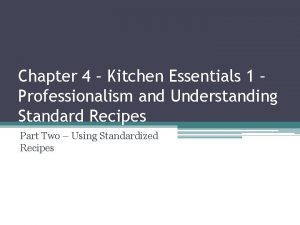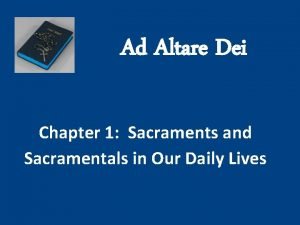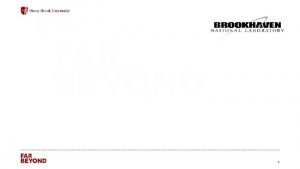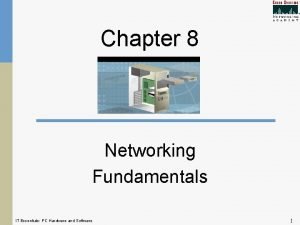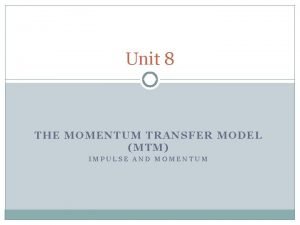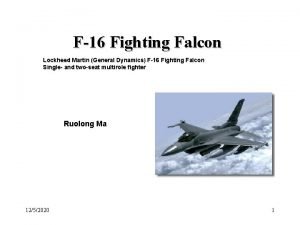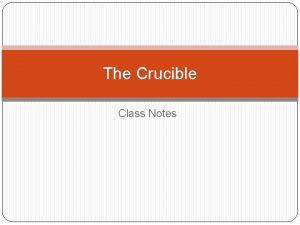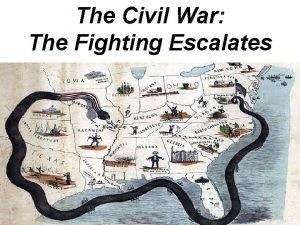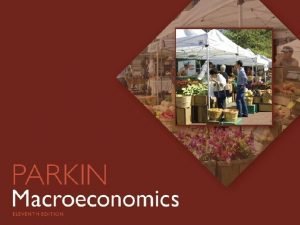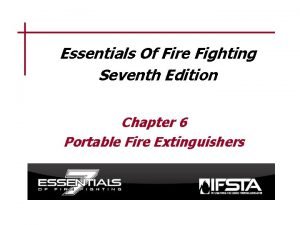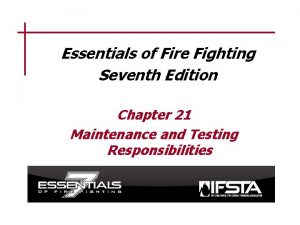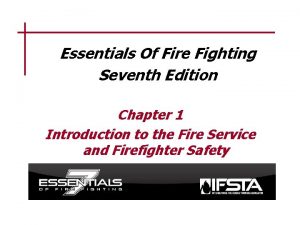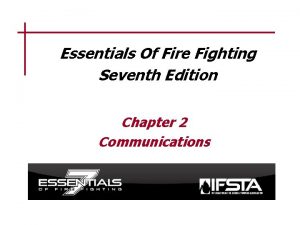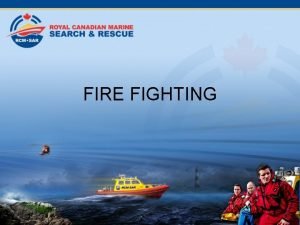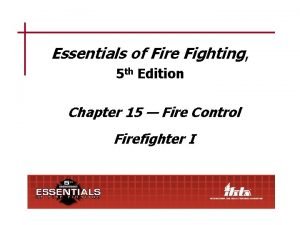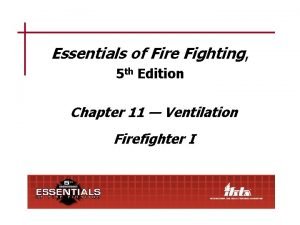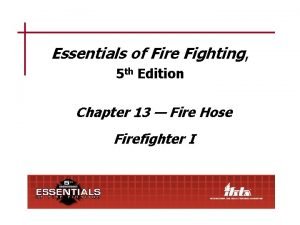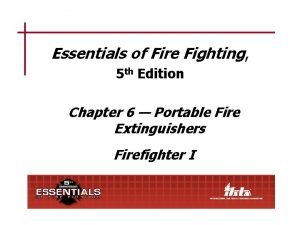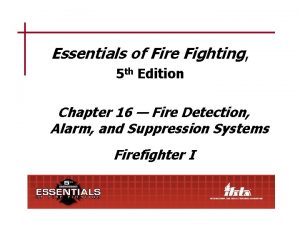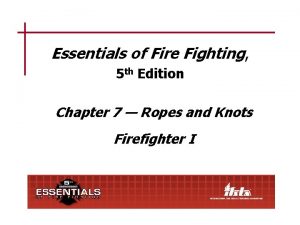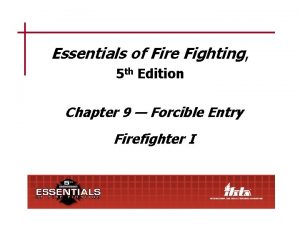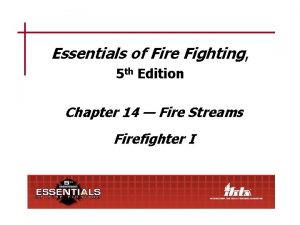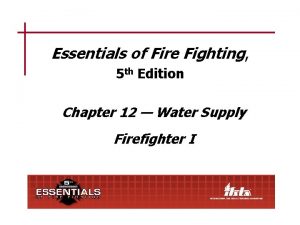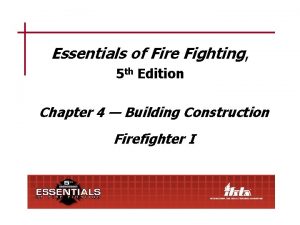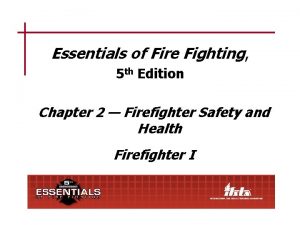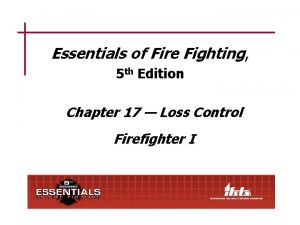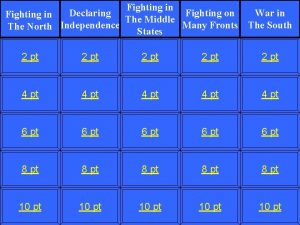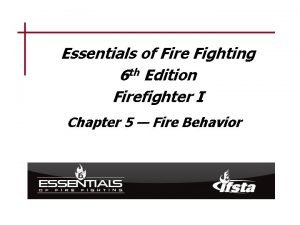Essentials Of Fire Fighting Seventh Edition Chapter 16

























































































- Slides: 89

Essentials Of Fire Fighting Seventh Edition Chapter 16 Building Materials, Structural Collapse, and Effects of Fire Suppression

Learning Objective 1 Describe the effects of fire on various building materials. 16– 1

Building Materials Some contribute to the fuel load Some prevent or limit fire spread Knowledge of how materials react to heat exposure will give an idea of what to expect from fire in a particular type of construction 16– 2

Common Building Materials Wood Engineered wood Masonry Metals Reinforced concrete Gypsum Lath and plaster Glass/fiberglass Plastic Composite or engineered materials 16– 3

Wood Most common building material in North America Main component of many structural assemblies 16– 4

Size Affects How Wood Reacts To Fire Smaller dimensio n lumber • Easier to ignite • Loses structural integrity faster • Needs to be protected by insulation to increase heat and fire resistance Larger dimensio n lumber • Difficult to ignite • Retain structural integrity after prolonged exposure to direct flame 16– 5

Moisture Content And Fire Retardants Wood with high moisture content • Does not ignite as readily or burn as fast as kiln dried or dehydrated wood Fire retardants • Wood is sometimes treated to reduce speed it ignites or burns • Not fully effective in reducing fire spread 16– 6

Masonry Bricks Stones 16– 7 Concret e blocks (Cont. )

Masonry Minimally affected by fire and high temperatures Spalling — Concrete Bricks Stones and blocks may rarely show concrete crack, but signs of may lose usually loss of small retain most integrity or portions of of their serious their strength deterioratio surface and n when stability heated Heat may degrade mortar (Cont. ) 16– 8

Masonry 16– 9

Metals 16– 10 (Cont. )

Metals Effect of heat and fire depends on • Type of metal • Whether metal is exposed or covered Uses • Structural support • Decorative covering • Fasteners 16– 11

Cast Iron Common uses in the 19 th century • Structural support beams and columns • Stairs • Balconies • Railings • Elevators • Building facades Stands up well to fire and intense heat May crack or shatter when rapidly cooled with water Bolts or connections can fail during fire 16– 12

Wrought Iron Early 1800 s building uses • Nails • Straps • Tie rods • Railings • Balconies Uses after 1850 • Rail and I-beams • Channels • Support columns Uses today • Gate, fence, and balcony railing decorations 16– 13

Steel Uses • Structural support • Stairs • Wall studs • Window and door frames • Balconies and railings • Roofs • Reinforcement for concrete floors, roofs, and walls (Cont. ) 16– 14

Steel (Cont. ) 16– 15

Steel (Cont. ) 16– 16

Steel Temperature at which a steel member fails depends on many variables Fireproofing materials are used to reduce effect of heat on structural members Awareness of type of steel members used is vital Firefighters need to determine how long steel members have been exposed to heat 16– 17 (Cont. )

Steel 16– 18

Steel Begins losing structural integrity at temperatures common in structure fires • Around 570°F (300°C) • At flashover temperatures, steel is likely to have failed • If not collapsed, stay out of the collapse zone • Steel will support 40% or less than the design load and can fail any time after flashover Always consider what effect heat is having on structural elements, even if you cannot see them Elongating steel can push out load-bearing walls and cause collapse 16– 19 (Cont. )

Aluminum Acoustical tile ceiling supports can create entanglement hazards Uses • Decorative features • Roofing • Flashing • Gutters • Downspouts • Siding • Window frames • Door frames • Exterior curtain wall panels • Sun rooms • Screened porches • Car ports • Awnings Heat affects aluminum more quickly than steel (Cont. ) 16– 20

Aluminum 16– 21

Other Metals Tin Copper • Ceiling tiles • Roof covering Lead • Wiring • Pipes • Flashing • Gutters • Compone nt in • Decorativ stained e glass elements All will fail when exposed to excessive heat 16– 22

Reinforced Concrete Poured at the site or precast Reinforced with rebar or wire mesh (Cont. ) 16– 23

Reinforced Concrete Exposure to fire • Performs well • Can lose strength through spalling • Prolonged heating can prompt failure of bond between concrete and steel reinforcement • Cracks and spalling indicate that damage occurred and strength may be reduced Prolonged exposure to chemicals • Can cause steel reinforcing bars to corrode and concrete bond to weaken 16– 24

Gypsum Also known as drywall or Sheetrock® (Cont. ) 16– 25

Gypsum High water content — Absorbs heat as moisture evaporates Excellent heat-resistant and fire-retardant properties Breaks down gradually under fire conditions Commonly used to insulate steel and structural members In areas where gypsum has failed, structural members behind it will be subjected to higher temperatures and could fail 16– 26

Lath And Plaster Lath Plaster 16– 27 (Cont. )

Lath And Plaster Generally found in buildings constructed before 1950 Wire mesh used to replace lath for ceilings in some houses Can be difficult to penetrate with axes or hand tools Can conceal fire within the cavity between surfaces Can add fuel to the fire 16– 28

Glass (Cont. ) 16– 29

Glass Fire and forcible entry Uses • Not typically used for structural support • Glass sheets for doors and windows • Glass blocks for nonload-bearing walls • Wire-reinforced glass may provide some thermal protection • Conventional glass is not effective as a barrier to fire extension • Heated glass may crack or shatter when cold hose stream hits the glass • Safety film or wire in the glass may impede breaking or forcing windows 16– 30

Fiberglass Typically used for insulation Glass component is not a significant fuel Binding materials may be combustible and difficult to extinguish 16– 31

Plastic Uses Vinyl siding Water and sewer pipes 16– 32 Decorative moldings, wall coverings, and mantel pieces (Cont. )

Plastic Most will melt and contribute to the fuel load 16– 33

Composite Or Engineered Materials Frequently substituted for wood or steel framing Lightweight High structural strength Corrosion resistant Resistant to chemical wear Heat resistant 16– 34 (Cont. )

Composite Or Engineered Materials Plywood OSB Particleboa rd Fiberboard May be highly combustible Can produce significant toxic gases Can rapidly deteriorate under fire conditions 16– 35 (Cont. ) Paneling

Composite Or Engineered Materials Finger-jointed timber Synthetic wood Laminated timber Particleboard Medium density fiberboard (MDF) 16– 36

REVIEW QUESTIONS Which type of building material best retains its structural stability under fire conditions? What determines the effect that fire has on metal? 16– 37

REVIEW QUESTION How are engineered or composite building materials used in building construction? 16– 38

DISCUSSION QUESTIONS What materials were used to build the structure that you are currently occupying? How are those materials likely to react under fire conditions? 16– 39

Learning Objective 2 Describe factors that contribute to structural collapse. 16– 40

Structural Collapse 16– 41

Fire Factors Contributing To Structural Collapse Factors to consider when determini ng potential for structural collapse • Renovations • Additions • Alterations • Age of structure • Weather • Loads placed on the structure • Construction type • Building condition • Length of fire exposure • Stage of fire • Building contents 16– 42

Construction Type Structural collapse involving high-rise or Type I buildings are limited Collapse due to earthquakes generally involve smaller buildings Steeples, water tanks, chimneys, and false facades that extend above the structure must be viewed as collapse hazards Collapses usually involve brick or masonry structural components or veneer Collapse can occur after fire is extinguished Ensure structural stability before entering the site (Cont. ) 16– 43

Construction Type I collapse • Not likely to collapse • Primary concern is flying glass • Contents burn, not the structure • If collapse occurs, it will be localized, not structure-wide 16– 44 (Cont. )

Construction Type II collapse • When exposed to temperatures above 1, 000° F (537° C), unprotected steel will expand twist, pushing walls out and will constrict when cooled • Movements will cause floors and wall to collapse • Construction with brick and block walls that support unprotected steel bar joists and I-beams are prone to these types of collapse (Cont. ) 16– 45

Construction Type III collapse • Ordinary construction • Exterior load-bearing walls made of concrete, brick, or masonry • Interior loads carried by wood, masonry, or unprotected steel • Masonry will collapse in one piece or crumble • Debris can travel and cause collapse of other structures or objects 16– 46 (Cont. )

Construction Type IV collapse • Heavy-timber or mill construction • One of the least likely to collapse • Weight-bearing capacity of largedimension wood members will resist collapse unless they have been affected by large volume of fire 16– 47 (Cont. )

Construction Type V collapse • Walls may collapse inward or outward • Plan for a collapse zone • Non load-bearing veneer walls are placed over load -bearing wood walls • Brick veneer can fall straight down (curtain collapse) or out • Rare to collapse outward • Inward collapse poses great danger to firefighters • Lightweight trusses and engineered floor systems can fail in minutes 16– 48 (Cont. )

Construction Type How long structural members remain intact when exposed to fire • Lack of evidence due to variety of types of loads or forces each component may be subjected to during fire • Analysis continues, but some results have been released • Very little difference between collapse times for steel bar joist-supported roofs and woodtruss supported roofs — Both are prone to rapid collapse (Cont. ) 16– 49

Construction Type Collapse of structures using lightweight construction can occur early and without warning Thorough preincident survey and size-up will provide some indication of the presence of lightweight construction 16– 50

Building Condition of a building can influence potential for collapse • Old, improperly maintained, or abandoned buildings pose greater risk of collapse than new, properly maintained, occupied structures • Construction materials can deteriorate and weaken as a structure ages • If abandoned or not properly maintained, deterioration can worsen and increase possibility of collapse 16– 51 (Cont. )

Building Condition Abandoned buildings • Pose greater danger of fire and collapse • Interiors may be gutted • Squatters may alter the interior, including load bearing supports, utilities, and power supplies 16– 52

Length Of Fire Exposure Longer exposure to high heat release rates Length of time structure maintains integrity is affected by Greater damage and risk of collapse • Size • Compartmentation • Construction type • Fuel load and materials 16– 53

Stage Of Fire Incipient • Not enough heat or flame to cause unprotected steel or wood frame construction to collapse Growth stage • Collapse potential increases 16– 54 Decay stage and postsuppressio n • Collapse becomes very likely due to weakened structural members and buildup of water (Cont. )

Stage Of Fire 16– 55

Building Contents Generate higher temperatures and rapid combustion that will weaken the structure due to higher fuel load Cause collapse more rapidly due to added dead weight Increase stress on structural members due to increased weight from water retention Knowledge of contents is gained through preincident surveys and inspections 16– 56 (Cont. )

Building Contents Storage in attics and concealed spaces • Not visible during preincident surveys • Often heavier than ceiling joists are designed to carry • Increases potential for weakened ceiling joists to fail • Common in residential dwellings • Has caused firefighter fatalities in industrial fires 16– 57

REVIEW QUESTIONS How does building construction type affect structural stability and the likelihood of collapse? How can a building's contents contribute to structural collapse? 16– 58

Learning Objective 3 Identify indicators of structural instability and collapse. 16– 59

Indicators Of Structural Instability And Collapse Roof sagging, pulling aware from parapet walls, or feeling spongy Fire involvement of trusses and engineered structural components Floors sagging or feeling spongy Chunks of ceiling tiles or plaster falling Movement in roof, walls, or floors Noises caused by structural movement (Cont. ) 16– 60

Indicators Of Structural Instability And Collapse Little or no water runoff from the interior Cracks in exterior walls with smoke or water appearing through the cracks Presence of tie rods Loose bricks, blocks, or stones falling Deteriorated mortar between masonry Walls that appear to be leaning (Cont. ) 16– 61

Indicators Of Structural Instability And Collapse Structural members that appear distorted Fires beneath floors that support heavy loads Prolonged fire exposure to structural members Structural members pulling away from walls Excessive weight of building contents 16– 62

WARNING Structural collapse can occur with little warning. If indicators start to appear, collapse may be imminent and personnel must withdraw from the structure and the collapse zone. 16– 63

REVIEW QUESTION What are four indicators of structural collapse? 16– 64

Learning Objective 4 Explain considerations to be taken when establishing collapse zones. 16– 65

Establishment Of Collapse Zones Apparatus and personnel operating master stream appliances must not be positioned in collapse zones Must be established adjacent to exposed exterior walls Estimation • Traditionally estimated by multiplying height of the structure by 1½ • As structures increase in height this is impractical because it limits space for defensive fire fighting operations 16– 66 (Cont. )

Establishment Of Collapse Zones Collapse zones established when • Indication that the structure has been weakened by prolonged exposure to fire or heat • Defensive strategy is adopted • Interior operations cannot be justified Considerations for collapse zone size • Type of building construction • Exposures • Safest location for apparatus and personnel 16– 67 (Cont. )

Establishment Of Collapse Zones Safest location for defensive operations is at the corner of the building 16– 68

REVIEW QUESTION How far from a building should a collapse zone extend? 16– 69

Learning Objective 5 Describe actions that should be taken when structural collapse is imminent. 16– 70

Actions Taken When Collapse Is Imminent As crew exits the building, inform Command others inside of the situation Establish and clear collapse zone as soon as possible Roll call or PAR should be conducted to ensure personnel safety Know and heed evacuation or other emergency signals used by your department 16– 71

REVIEW QUESTION What are three actions that must be taken if it becomes apparent that a structure is going to collapse? 16– 72

Learning Objective 6 Describe building conditions and fire suppression activities that can impact fire spread and structural stability. 16– 73

Dangerous Building Conditions that contribute to spread and intensity of fire Conditions that make building susceptible to collapse 16– 74 (Cont. )

Dangerous Building Conditions Construction type and elapsed time of structural integrity • The longer the fire has been burning, the more likely that integrity has been compromised Fuel load of structural members and contents • Fuel load — Maximum heat that can be produced if all combustible materials burn • The higher the fuel load and more combustible the fuel packages, the longer and hotter a fire will burn (Cont. ) 16– 75

Dangerous Building Conditions Building compartmentati on • Higher level of compartmentation provides more fire barriers • Open floor plans may contribute to fire spread • Fire can move through interstitial spaces in walls, ceilings, and floors (Cont. ) 16– 76

Dangerous Building Conditions Construction features • Heat exposure to lightweight or engineered materials may contribute to faster, possibly unexpected collapse • Insulation can retain heat Construction, renovation, and demolition hazards • Building systems may not be operational • Abandoned buildings may be structurally unsound and missing normal fire barriers 16– 77

REVIEW QUESTION What are five building conditions that contribute to fire spread? 16– 78

Effects Of Building Ventilation Systems On Tactical Ventilation HVAC systems can affect tactical ventilation • Move heated or cooled air through a structure • During fire, ducts can move heated air and products of combustion from involved compartments to other compartments • Heated gases can heat up materials in uninvolved compartments until those materials ignite • Heated flammable products of combustion may ignite when they mix with oxygen in the ventilation system or uninvolved compartments (Cont. ) 16– 79

Effects Of Building Ventilation Systems On Tactical Ventilation 16– 80 (Cont. )

Effects Of Building Ventilation Systems On Tactical Ventilation Some HVAC systems are designed with smoke detectors or dampers • During fire, smoke activates a detector which activates dampers • Dampers close, blocking air flow through affected ducts Some HVAC systems function as smoke evacuation systems • During fire, these isolate the HVAC function • Draw smoke and gases from involved compartments or control pressurization within the structure (Cont. ) 16– 81

Effects Of Building Ventilation Systems On Tactical Ventilation Smoke damper in an HVAC duct 16– 82

REVIEW QUESTION How can a building's HVAC system affect fire spread? 16– 83

Added Water Load From Suppression Activities Water used to suppress the fire can directly affect the structure Every U. S. gallon (SI liter) used adds 8 to 10 pounds (4 to 5 kg) of weight to floors that may already be weakened Added weight may cause floors to pancake down or push walls out, resulting in complete structural failure Estimate — 250 gpm (1 000 L/min) adds 1 ton (900 kg) of water per minute to the structure 16– 84

Collapse Considerations After Extinguishment Salvage and overhaul • Protect contents • Ensure fire is extinguished and will not rekindle • Ensure structure is secured and safe to leave to the property owner 16– 85 (Cont. )

Collapse Considerations After Extinguishment Damage made to load bearing components could lead to collapse • Exercise caution when cutting through walls • Examine floors to ensure they will support movement of heavy property Lumber is used to secure the structure • Reinforce or anchor damaged structural components • Plywood or OSB covers doors, windows, and holes in walls or the roof 16– 86

REVIEW QUESTION How can salvage and overhaul activities affect structural stability? 16– 87

QUESTIONS Are there any questions about this content? 16– 88
 Business essentials 12th edition
Business essentials 12th edition Starving in fire fighting
Starving in fire fighting Shipboard fire fighting organization
Shipboard fire fighting organization Physical states
Physical states Siphip
Siphip The success of an indirect attack on a fire depends on the
The success of an indirect attack on a fire depends on the Fire fighting methods
Fire fighting methods Solid-stream nozzle in fire fighting
Solid-stream nozzle in fire fighting Fire extinguisher in urdu
Fire extinguisher in urdu Foampro fire fighting
Foampro fire fighting Basic fire fighting training ppt
Basic fire fighting training ppt Negative pressure ventilation firefighting
Negative pressure ventilation firefighting Broken stream fire fighting
Broken stream fire fighting Purpose group ubbl
Purpose group ubbl Clean agent fm 200 fire suppression systems in uae
Clean agent fm 200 fire suppression systems in uae Fire sprinkler head gpm chart
Fire sprinkler head gpm chart 3 layers of muscle
3 layers of muscle Database system concepts seventh edition
Database system concepts seventh edition Information systems literacy
Information systems literacy Molecular biology of the cell seventh edition
Molecular biology of the cell seventh edition Biology seventh edition
Biology seventh edition Network security essentials 5th edition
Network security essentials 5th edition Essentials of investments 11th edition
Essentials of investments 11th edition Business essentials 12th edition answer key
Business essentials 12th edition answer key Essentials of sociology 5th edition
Essentials of sociology 5th edition Firefighter essentials 7th edition
Firefighter essentials 7th edition Business essentials 12th edition
Business essentials 12th edition Voyage estimating decision support system
Voyage estimating decision support system Essentials of organizational behavior 14th edition
Essentials of organizational behavior 14th edition Cryptographic systems are generically classified by
Cryptographic systems are generically classified by Criminal justice the essentials 5th edition
Criminal justice the essentials 5th edition Chapter 40 fighting the cold war at home
Chapter 40 fighting the cold war at home Figured bass seventh chords
Figured bass seventh chords Mis chapter 6
Mis chapter 6 Report
Report A gift of fire 4th edition
A gift of fire 4th edition A gift of fire 4th edition
A gift of fire 4th edition Reichstag fire who was the fire starter
Reichstag fire who was the fire starter Damper fire alarm
Damper fire alarm Uttar pradesh fire prevention & fire safety rules, 2005
Uttar pradesh fire prevention & fire safety rules, 2005 A-e rwi
A-e rwi Race fire safety
Race fire safety It essentials chapter 8
It essentials chapter 8 5 essentials for a successful ffa chapter
5 essentials for a successful ffa chapter It essential chapter 9
It essential chapter 9 It essentials chapter 14
It essentials chapter 14 It essentials chapter 12
It essentials chapter 12 It essentials chapter 11
It essentials chapter 11 Marketing essentials chapter 38
Marketing essentials chapter 38 Chapter 13 initiating the sale answer key
Chapter 13 initiating the sale answer key In what way is marketing related to form utility
In what way is marketing related to form utility It essential chapter 5
It essential chapter 5 It essentials chapter 3
It essentials chapter 3 It essentials chapter 11
It essentials chapter 11 Essentials of social media marketing chapter 9 quiz
Essentials of social media marketing chapter 9 quiz It essentials chapter 7
It essentials chapter 7 It essentials chapter 6
It essentials chapter 6 It essentials chapter 5
It essentials chapter 5 It essentials chapter 4
It essentials chapter 4 Math is the foundation of the kitchen and the back office.
Math is the foundation of the kitchen and the back office. It essentials chapter 2
It essentials chapter 2 It essentials chapter 5
It essentials chapter 5 Cisco it essentials virtual desktop pc assembly online
Cisco it essentials virtual desktop pc assembly online It essentials chapter 10
It essentials chapter 10 It essentials chapter 10
It essentials chapter 10 Ad altare dei answers chapter 1
Ad altare dei answers chapter 1 Marketing essentials chapter 2
Marketing essentials chapter 2 It essentials chapter 4
It essentials chapter 4 It essentials chapter 7
It essentials chapter 7 What are the ten essentials of a successful ffa chapter
What are the ten essentials of a successful ffa chapter What copper cored cable is surrounded by a heavy shielding
What copper cored cable is surrounded by a heavy shielding It essentials chapter 6
It essentials chapter 6 _______is considered as moist method of cooking.
_______is considered as moist method of cooking. It essentials chapter 13
It essentials chapter 13 When fighting fires a firefighter must use great caution
When fighting fires a firefighter must use great caution Romeo and juliet
Romeo and juliet Israeli fighting system
Israeli fighting system Kite fighting techniques
Kite fighting techniques Paper kites doncaster
Paper kites doncaster Why are the von gradwitz and znaeym families fighting
Why are the von gradwitz and znaeym families fighting General dynamics f-16cm fighting falcon
General dynamics f-16cm fighting falcon Dove
Dove A navy diver is not a fighting man
A navy diver is not a fighting man Social class in the crucible
Social class in the crucible The civil war the fighting escalates
The civil war the fighting escalates Fighting means corporations
Fighting means corporations Polish people fighting
Polish people fighting Fighting taking on
Fighting taking on Whom had macbeth and banquo been fighting?
Whom had macbeth and banquo been fighting? Fighting inflation means on
Fighting inflation means on

